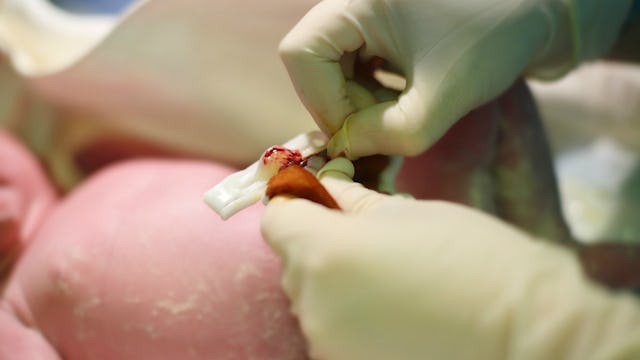You Can Donate Your Placenta, And Here's Why You Should

I was in the hospital about to have an emergency C-section for my first birth, a set of boy/girl twins, when the nurse was asking me all of the questions. After all of my yes’s and no’s, she asked me the weirdest one of them all, “Would you like to donate your placentas today?”
Uhhh… donate my placentas? What kind of birth sorcery is this?
But actually, it turns out donated placentas have a growing number of medical uses because its tissue is so similar to a form of fascia found all over the body.
Fascia is a band of tissue found under the skin connecting and covering things like bones, nerves, muscles, tendons, organs, the spinal cord and even the brain. So if trauma or surgery disrupts the natural fascia covering, amniotic membranes serve as an extremely similar, if not precise, transplant for individuals.
Not only that, but did you know that the placenta is actually an organ? So really, a placenta donation is not unlike other types of organ donation.
But unlike more “traditional” organ donations, one placenta has the opportunity to help dozens of patients for things like:
Spine therapy
Individuals suffering with back pain from trauma, previous surgery, or medical conditions might benefit from placenta tissue injections. Much like the name states, these injections serve as a regenerative form of medicine, and it comes from the amniotic placenta tissue. Not only is it all-natural and anti-immunogenic (low risk of rejection), but it may also serves as a non-surgical treatment for damaged tissues found in tendons, ligaments, inflamed tissue, as well as the degenerated joints. Much like steroid injections, placenta tissue injections may reduce pain and inflammation, support correct tissue reconstruction and prevent scar tissue formation.
Difficult to treat wounds
Doctors can use amniotic membranes to help heal difficult to treat wounds such as diabetic foot ulcers, venous leg ulcers, pressure ulcers, burns, and other wounds that do not progress past the inflammatory stage of healing.
With the staggering number of 8-10% of Americans being diagnosed with diabetes, amniotic membranes continue to prove as a huge asset in the healing of diabetic foot ulcers affecting up to 25% of diabetic Americans. With it’s antibacterial properties, there is little to no risk of infection, and it aids as a great biological barrier between the wound and the rest of the world.
Amniotic membrane isn’t just being used in difficult to treat wounds either, some surgeons are adapting to the use of this method for surgical incision sites in post-operative care to hopefully speed the healing process.
Eye therapy
Certain ophthalmology research has already identified a relationship between human placenta and eye tissue, so it’s not out of the box that donated placentas be used in certain eye therapy and procedures.
Placental amniotic membranes provide healing properties that help restore vision in patients with ocular disease, who may have been unresponsive to previous treatment. (In case you aren’t picking up on all of that, a mother’s donated placenta literally has the ability to help another person see.)
Toronto East General Hospital is one of a few hospitals in Canada using amnion (the inner layer of amniotic membrane, the sac that protects the baby from harm) harvested from planned caesarean sections at the hospital for eye surgeries in the hospital and the surrounding province.
Dr. Charlotte Wedge, the chief of ophthalmology at Toronto East General Hospital, says each placenta produces about 45-50 pieces of amniotic membrane and has the ability to help approximately three dozen eye patients.
According to Wedge, the amniotic membrane acts much like a scaffold when used during surgery, allowing other cells to rebuild and grow around the surface of the membrane which ultimately helps progress the wound healing process.
“[Amniotic membrane] has quantities that quiet inflammation,” Wedge says. “It represses new vessels from growing and causing inflammation and scarring…. it seems to quiet everything.”
Dental therapy
Amniotic tissue continues to show great promise in the area of dentistry involving gum disease. Normally patients with advanced gum disease would undergo a procedure which harvests tissue from his/her soft palate to reduce gum tissue previously lost. The hope is that this soft palate tissue will provide a solid structure for the regrowth of new cells.
But thanks to placental donation, amniotic membranes can do everything harvested soft palate tissue can, if not more. Not only is this giving physicians and patients more options, but it’s also lessening recovery time as well as pain because of fewer interventions are necessary.
Stem Cell Research
The placenta contains within it a rich source of stem cells, the body’s alpha-cells. Donated placentas allow researchers to harvest these stem cells which could be used to help treat a magnitude of disorders and diseases. To name just a few: cancer, cystic fibrosis and Parkinson’s disease.
The medical advances using donated placentas continues to advance. The way I looked at it when I was asked about donation was this: I can either help someone, or I can do nothing. I chose to help someone and do something, even if all I had to do was check “yes” on a box and sign my name on a piece of paper.
Donating your placenta is not just about donation; it’s about providing healing. Don’t let your placenta go to medical waste.
This article was originally published on